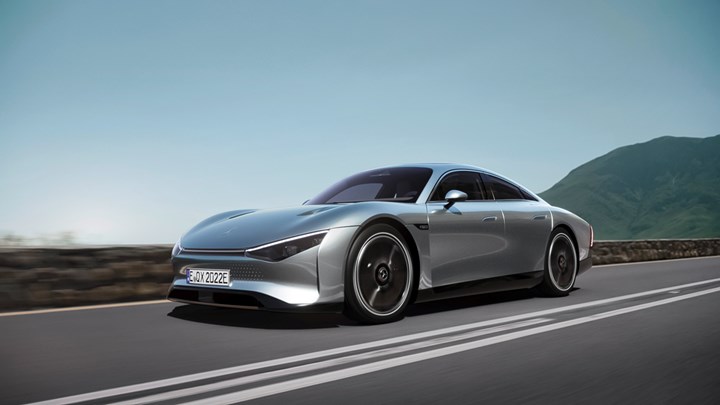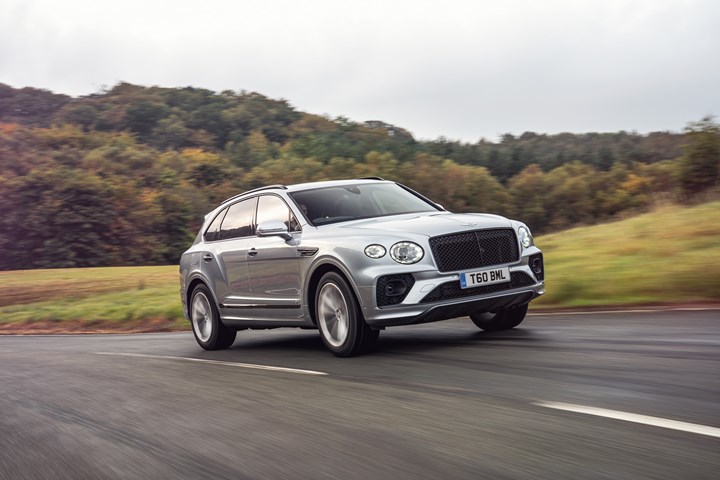On Tractors, Autonomy and a Clever Mercedes Concept
On giving farmers a break. . .a concept car with some actual process tech. . .advancing autonomy via vision and software. . .VW exec on EVs. . .and the sales of a brand most of us can’t afford
#electronics
The Deere 8R Driverless Edition

That John Deere tractor is working at a speed up to 15 mph. If you look closely, you’ll see that no one is behind the wheel—because there isn’t. Deere has developed autonomous tech. (Image: Deere)
Joe Liefer, senior product manager at John Deere, says that the Deere 8R is the company’s “flagship, workhorse tractor.”
The 8R has been available for about a decade, and during that time there have been an array of models and developments. It is a vehicle that plenty of farms have plowing fields.
In 2020, for example, a farmer could get an 8R 370, a 370-hp vehicle with an available infinitely variable transmission, independent link suspension, and three cab and visibility packages.
And standard “JDLink telematics system” that brings a “StarFire 6000 Integrated Receiver and Generation 4 CommandCenter Display”; there is AutoTrac assisted steering. The tractor has GPS. The guidance provided is ±1.2 inches.
Tech like this is part and parcel of the ag equipment being developed by Deere. Yes, there is a whole lot more to these tractors than you might expect.
==
Two things you probably don’t know about John Deere
- In September 2017 it acquired Sunnyvale, California-based Blue River Technology. Blue River was established in 2011 by two Stanford grad students who decided to bring machine learning, computer vision and robotics to agriculture.
- In August 2021 Deere acquired Bear Flag Robotics, a Newark, California-based company focused developing autonomous systems for agricultural equipment that can be deployed on existing equipment.
Moline, Illinois, is a lot closer to Silicon Valley than you might think.
==
Which brings us back to Liefer and the 8R.
Liefer is senior product manager for Autonomy at John Deere.
And the 8R in question is the model introduced at CES last week.
The tractor is fitted with six pairs of stereo cameras. There is a deep neural network deployed. A NVIDIA Jetson GPU handles processing.
Liefer says they started collecting images for machine learning on farms across the U.S. in 2019 and have some 50 million accumulated.
Liefer points out that tractors have been self-driving for years, based on GPS and an RTK (real-time kinematic) network.
But with a farmer on board.
The new autonomous set-up is driver-free.
==
The front cameras are used to assure the path ahead is clear. Should there be something encountered, the tractor will stop until a determination is made of what it is.
The rear camera monitors the tool in the back.
But side cameras?
Liefer says that this is the view that farmers are typically interested in seeing: to make sure the rows are being made straight.
The farmer can monitor activities through the John Deere Operations Center Mobile app on their phone. Adjustments can be made through the phone.
==
Liefer acknowledges that there are not a lot of obstacles in a given field. But being able to handle the exceptions is a big challenge. What’s more, he says that safety was paramount in the development of the system.
While no strangers to lidar or radar, Liefer says that open-field agriculture is a different autonomous vehicle challenge than that of driving on the road—and he points out that the autonomous 8R must be driven, with a driver, to the field: it doesn’t operate autonomously on the road.
What’s more, they were focused on keeping the price of the system down, so the sensors that can do the job. . .do the job.
==
A big difference between an automotive autonomous system and Deere’s approach: a late-model 8R can be taken in to a Deere dealer and have it retrofitted in about eight hours for autonomous capability. Cameras, software, processors, redundant brakes—these and other mods.
There isn’t a need for a new tractor.
Of course, Deere certainly wouldn’t mind were someone to opt for a new rig rather than taking the retrofit approach.
///
Mercedes VISION EQXX: Two Things

The Mercedes VISION EQXX is a stylish execution of what could be an immensely desirable electric vehicle that would offer a range of 620 miles on a charge. While it is a real car, it is a concept vehicle. (Image: Mercedes-Benz)
Last week Mercedes-Benz introduced the VISION EQXX. It is a concept car that the company claims was executed in 18 months.
It undoubtedly was. But realize this is a concept, not a production vehicle.
Ola Källenius, Chairman of the Board of Management of Daimler AG and Mercedes-Benz AG, said the vehicle is “the most efficient Mercedes-Benz [has] ever built – with an outstanding energy consumption of less than 10 kWh per 100 kilometers. It has a range of more than 1,000 kilometers on a single charge using a battery that would fit even into a compact vehicle. The VISION EQXX is an advanced car in so many dimensions – and it even looks stunning and futuristic. With that, it underlines where our entire company is headed: We will build the world’s most desirable electric cars.”
Just one thing: note the future tense (“will”). That range of ~620 miles is certainly impressive. Still. . .
The VISION EQXX is a concept car not a production vehicle. That is worth repeating because a Lucid Air, an actual EV that is available for purchase right now, one being built on a line in a factory in Arizona, has a range of 520 miles, and that is an accomplishment that should not be overlooked.
It may be the most efficient Mercedes they’ve ever built. But there is a difference between it and something that will roll off the line in Sindelfingen.
- The nomenclature
“EQ” is what Merc is using for its electrified vehicles.
“XX”?
Markus Schäfer, Member of the Board of Management of Daimler AG and Mercedes-Benz AG, Chief Technology Officer responsible for Development and Procurement:
“The XX suffix augments the Mercedes-Benz brand with the X-factor of electric mobility that thinks beyond limitations, and an agile, X-divisional collaborative development approach.”
While that first X may be rhetorical, the cross-functionality X isn’t.
For example:
The team included people who ordinarily work on the Mercedes F1 program at Mercedes-AMG High Performance Powertrains (HPP) in Brixworth, UK.
The roof has 117 solar panels affixed. The setup was developed with the Fraunhofer Institute for Solar Energy Systems ISE. It is said to be Europe's largest solar energy research institute.
They worked with BrainChip, out of Laguna Hills, CA, on “neuromorphic computing,” an approach that uses AI so that there is on-board learning and low energy requirements.
Plenty of cross-functionality.
- Big casting
It is described as “the largest aluminum structural casting at Mercedes-Benz.”
It is named the “BIONEQXX.”
It is, more prosaically, the rear floor section of the car.
The “BIONE” part comes from the design approach. As in “bionic.” The company actually introduced the “Mercedes-Benz bionic car” in 2005.
The approach is one part aero focused, one part structural efficiency (mass where it needs to be; subtracted from where it doesn’t). The casting saves from 15 to 20% of the mass of a conventionally designed/produced component.
Because there are some voids in the structure, and because that structure is open to the elements, the designers and engineers worked with UBQ Materials to develop patches to cover the holes that could let in water and dirt.
The patches are made from landfill waste. They are 3D printed in order to have optimized shapes. There are 42 patches in all.
Some reality
Mercedes is actually using the design method and casting process in production (i.e., for non-conceptual vehicles).
They are calling it. . .”BIONICAST.” (And trademarked it.)
It is probably worth noting—and probably somewhat annoying to those in Stuttgart as the theoretical VISION EQXX is said in the same breath as that pesky company from Silicon Valley—that Tesla has been using a massive single-piece aluminum casting for the Model Y for more than a year.
///
A Brief Look at Mobileye

Mobileye has collected some 200 petabytes of data to help minimize the mean time between failures of its automated driving tech. How much is that? One petabyte equals 1,000 terabytes. One terabyte equals 1,000 gigabytes. So a lot. As you’ll notice if you look closely: it even has lots of pictures of central European tractors. (Image: Mobileye)
Mobileye, the Intel-owned company that isn’t getting as much attention as firms like Waymo and Cruise, has been consistently working with companies including Volkswagen and Ford to develop its advanced driver assistance technology.
While early on it was positioned primarily as a vision company, it has stretched its boundaries to encompass machine learning, mapping and data analysis.
It has been producing its own systems-on-a-chip (SoC), of which it recently shipped its 100 millionth.
Its current SoC is EyeQ5. According to Amnon Shashua, Mobileye president and CEO, it will start automotive-grade production of the EyeQ Ultra in 2025, which has the performance of 10 EyeQ5s.
The company claims that the SoC will have both the performance and the cost necessary for a consumer autonomous vehicle. And know Shashua is talking Level 4.
Leveraging the Swarm
One of the interesting things that Mobileye has been doing for the past several years, and continues to do so right now, is to accumulate “swarm data”: Obtaining information from vehicles equipped with Mobileye technology.
This data is sent to the cloud, where it is used to create high-definition maps.
This crowd-sourced data, used to develop “REM,” or “Road Experience Management,” is obtained in massive amounts:
25 million kilometers of road collected every day
REM is being used by VW for its Travel Assist 2.5 system. Ford will be deploying it in future versions of its BlueCruise system.
Fresh info delivered OTA.
“Software-defined Radar”
Although it may be vision-centric, Shashua says they are developing what he calls “software defined radar,” a radar system that is more robust and economical than that available today.
He says that an AV system, once the radar system is available, could be based on a single forward-facing lidar, then cameras and radars working to provide 360° visibility.
The Mobileye approach to creating redundancy for an AV is to have two subsystems, one based on cameras and the other on radar and lidar. Shashua says that a Level 2+ system can be based on vision alone (as well as REM and the necessary processors) but that it takes lidar and radar to get to Levels 3 and 4.
Level 4 Coming
And speaking of Level 4, Mobileye and Zeekr have announced that they’re developing a L4 consumer vehicle that will be available in the China market by 2024. It will deploy Mobileye “True Redundancy” sensing (the multi-sensor approach), REM mapping, and “Responsibility Sensitive Safety,” a policy-based approach that makes automated driving functions analogous to what a human driver would do.
///
Keogh on VW and EVs

Scott Keogh says that an objective that Volkswagen has is to make electric vehicles—like the ID.4—accessible to regular consumers, not just those for whom an EV may be something nice to have around. (Image: VW)
Scott Keogh, President and CEO, Volkswagen Group of America Inc., is a straight-shooter when it comes to his observations about VWoA and the industry at large. While not as flamboyant in his comments as, say, Bob Lutz, Keogh doesn’t spin as other CEOs have a tendency to do. (OK: he probably does spin, but there seems to be far less in the centrifugal stuff category.)
In a briefing last week, Keogh had some notable observations.
On electric vehicles
Keogh, of course, has the ID.4 in the game. In 2021 they sold 16,742.
“We could have sold four times that amount,” he claims, adding that there are more than 20K reservations for the vehicle. (While the ID.4 is presently imported from Zwickau, Germany, production at the Chattanooga plant will start mid-summer and be in full production by the fall.)
He thinks that EVs will be at 10% of the total market—not just VW—“relatively soon.”
Why buy?
Why will people buy? (Assuming that the chip situation doesn’t continue to impact vehicle production/availability, and Keogh thinks that vehicle shortages will continue until 2023 because there is existing demand that exceeds supply.)
“Before it was government and regulation. Now it is product and investment.”
Or: before it was the stick that government was applying to OEMs. Now OEMs are making product that people want to buy and are making the investments such that there will be availability to buy.
And on the subject of purchasing. . .
“We’re fanatical about getting the price point right. We want to draw mainstream Americans into EVs,” Keogh says.
The base MSRP for a 2022 ID.4 is $40,760. Plans call for a model with a smaller battery pack and other adjustments to be available for some $35,000 later this year.
Referencing the ID.4 customers in relation to the EV market leader, Keogh says, “These are not people who are buying their fourth car or who are making $400,000.”
And he noted that given the name of the company (put “volk” and “wagen” in Google Translate if you don’t know), one of the objectives is to reach a wide range of customers: “We do not see electrification as being just for the affluent but transformational for Americans across the board.”
What about a truck?
Given that plenty of Americans buy pickups, what is his view on a VW EV pickup?
“It is something I want to do.”
While the announcements from Ford and GM regarding their heritage in the pickup space being important underpinnings to their forthcoming EV pickup offerings, Keogh says that not having decades of an ICE pickup can be an advantage.
///
A Numerical Diversion in Some 2021 Sales

The Bentley Bentayga. Style. Substance. And, comparatively speaking, a big seller. (Image: Bentley)
While OEMs reported 2021 sales last week, and with them came now-well-known results—
- Toyota outsold GM in the U.S. Toyota had sales of 2,332,262. GM 2,218,228. The delta: 114,034. If Toyota didn’t have the Lexus RX—sales of 115,320—GM would have won. (However, here is a comparatively scary number for GM: Cadillac’s total sales for 2021 were 118,310. That’s just 2,990 more units than the Lexus RX.)
- The F Series is the best-selling truck for 45 years running and the best-selling vehicle for 40 years in a row. It sold 726,004. While champagne corks undoubtedly popped virtually among the truck team, things probably weren’t as bubbly over at Lincoln. Lincoln’s total 2021 sales were 86,929. Or 28,391 fewer units than RX sales.
--the results from Bentley Motors are in some ways more fascinating because. . .well, just because.
The VW Group’s British brand has three models in its lineup:
- Bentayga
- Continental
- Flying Spur
It sells vehicles in 67 countries.
Bentley’s biggest market?
The Americas.
Follow by, respectively, China, Europe, the U.K., Asia-Pacific, and the Middle East.
Its 2021 global sales were 31% better than 2020.
Its total 2021 global sales were:
14,659 vehicles
Sales in the Americas (4,212) and China (4,003) are 57% of the total.
The Bentayga—the SUV—was responsible for 40% of all sales and 20% of the Bentayga were hybrids.
To ratchet back to a previous consideration. . .
There were 15,631 Lincoln Navigators sold last year. Or 972 more than all Bentleys.
(Score one for Dearborn over Crewe.)
There were 5,864 Bentaygas sold.
Checking on the base price of a Bentayga (at the Bentley store in Newport Beach, of course), it is $177,000. Lincoln has an “Experience Center” in Newport Beach, but that is about experience, not commerce, so using Lincoln.com the base price for a Navigator is $76,705.
Although the world of retailing vehicles doesn’t exactly work this way, it is interesting to note:
$177,000 x 5,864 = $1,037,928,000
$76,705 x 15,631 = $1,198,975,855
To be sure, the margins on a Bentayga are undoubtedly much higher than those for a Navigator (after all, we are talking Bentley here), and the bill of materials much bigger for all of those Navigators, as well. Let’s face it: 23,456 tires are going to cost less than 62,524.
Still, there is something to be said for scale.
///
NACTOY ICYMI

(Image: NACTOY)
The 2022 North American Car, Truck and Utility of the Year (NACTOY) awards were presented Tuesday morning in Detroit at a meeting convened, in part, by the Automotive Press Association.
The winners are:
- Honda Civic. This is the 11th generation of the car. It is built at plants in Greensburg, Indiana, and Alliston, Ontario. The Civic bested the Lucid Air and the VW Golf R/GTI. This is a three-peat for Civic, which also won in 2006 and 2016.
- Ford Maverick. Think of it as “the little truck that can.” The base model is a hybrid, which sets it apart from every other truck out there. The Maverick competed with the Hyundai Santa Cruz and the Rivian R1T for the win. The popularity is impressive: turning on dealers’ lots in just four days.
- Ford Bronco. This is the return of what is legitimately considered an iconic Ford. The Bronco, part of Ford’s “Built Wild” offerings (!), was up against the Genesis GV70 and the Hyundai IONIQ 5.
RELATED CONTENT
-
GM Develops a New Electrical Platform
GM engineers create a better electrical architecture that can handle the ever-increasing needs of vehicle systems
-
Flying Car Flight of Fancy Gets Real
People have been dreaming about flying cars since the early days of the auto and aircraft industries.
-
Study: How States Should Update Traffic Laws for Autonomous Cars
U.S. states should require that all automated cars have a licensed driver on board, suggests a study by the Governors Highway Safety Assn.


.jpg;width=70;height=70;mode=crop)






